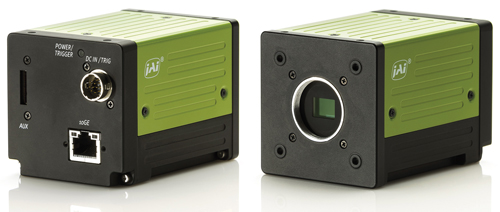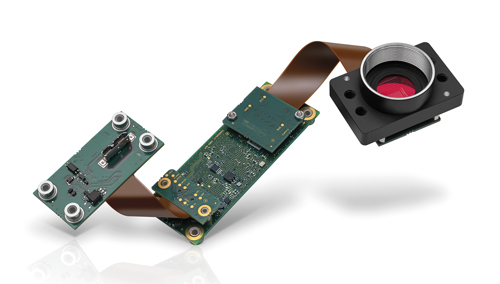Since its release in 2006, GigE Vision has seen incredible market adoption and this is no accident. With Ethernet ports native to all PCs, the prevalence of Ethernet networks, easy networking of multiple cameras, and cable lengths to 100 metres, GigE Vision has been an easy choice for many users. But the story gets better: GigE Vision is scalable to all speed grades of Ethernet, so, as computer chips get faster, GigE Vison will adapt to take advantage of the opportunities that greater speed makes available.
GigE Vision technical committee chair, Eric Bourbonnais from Teledyne Imaging, commented: ‘As people realised the potential of GigE Vision based on version 1.2 of the standard, multiple requests came to the technical committee to extend the capabilities of the standard.’ As a result, GigE Vision 2.0 introduced an extended GigE Vision streaming protocol (GVSP) packet to allow for future expansion. GigE Vision 2.0 uses this new packet format to transport compressed images and non-raster scan image output. Additionally, GigE Vision 2.0 introduces IEEE 1588, precision timing protocol support, which enables users to trigger multiple devices near simultaneously (sub micro-second accuracy) across the network using action commands, or gives a common time stamp for 1588-enabled devices for processing purposes, for example stitching. This greatly extends the utility of GigE Vision’s camera networking capabilities, coordinating multiple cameras with incredible timing precision.
For GigE Vision, in general, data is transported in a container called a block – an image is usually sent in one block. Before GigE Vision 2.1, a block was only allowed to contain one type of data – typically an image – plus one section of metadata. In GigE Vision 2.1 this limitation was overcome, and a block can be composed of multiple parts, each of which can contain data of different types. This allows a multitude of different uses beyond just 3D coordinates. For 3D use cases, all the data related to a scene can be transported in one single block where parts can be sent in parallel, whereas using a block per part would require sending the parts sequentially, which would be less efficient.

GigE Vision 2.1 also adds the following:
- It expands the IEEE 1588 profile to include 802.1AS, which is part of the time-sensitive networking (TSN) suite of standards;
- It mandates test features for enhanced interoperability;
- It introduces a mechanical supplement with additional connection options on the device end; and
- It leverages the pixel format naming convention (PFNC) from GenICam.
The technical committee is currently working on GigE Vision 2.2, which introduces GenDC support. This gives similar functionality as that introduced in 2.1, but uses a standard GenICam container format. GenICam is a standard hosted by the European Machine Vision Association, which started as a generic camera control (GenICam) layer common among all the standards. It is composed of a number of different modules; GenDC is a new GenICam module that allows the data container (DC) to be common among all the interface standards. James Falconer, vice chair of the GigE Vision technical committee from Pleora Technologies, said: ‘This is useful if a customer uses multiple transport layers – i.e. USB3 Vision and GigE Vision, for example – as the data seen by the user will have the same format, enabling fewer changes to software applications, thus simplifying and streamlining development.’
Jumping back to speed, GigE Vision is scalable to all Ethernet speed grades. As 2.5G, 5G and 10G network interface cards (NICs) are becoming more common and less expensive the market has seen the introduction of many cameras running faster than 1G. The AIA runs plug-fests twice a year across the globe, and last year the AIA needed to update its test equipment to accommodate up to 10G cameras.
For the future, in addition to following Ethernet speed upgrades, GigE Vision is looking into the changes required to use an NIC offload engine to reduce the CPU usage needed to receive streaming. CPU usage to receive data over GigE Vision increases with link speed, since currently the Ethernet roadmap indicates that Ethernet speeds will increase faster than CPU computing power. As such, GigE Vision will likely need to make use of these offload engines in order to move to higher throughputs in the future. With the success of Ethernet, GigE Vision will remain a dominant interface standard in the vision community.
The article was written together with Eric Bourbonnais and James Falconer, GigE Vision technical committee chair and vice chair respectively.
Commercial products
New cameras with a GigE Vision interface include the latest generation of JAI’s prism cameras in its Fusion series of multispectral imaging solutions. The FS-3200D-10GE and FS-1600D-10GE cameras have two-channel dichroic prisms that divide the incoming light into two precisely aligned CMOS area scan imagers. One channel captures light from the visible spectrum – approximately 400nm to 670nm – and delivers it to a Bayer colour sensor, while the second channel directs light from the near infrared portion of the spectrum – 740nm to 1,000nm – to a monochrome, NIR-sensitive sensor.
Both cameras have Bayer and monochrome versions. The FS-3200D-10GE model uses the Sony Pregius IMX252 CMOS sensor offering 3.2-megapixel resolution at 123fps for 8-bit output, while the FS-1600D-10GE is based on the Sony Pregius IMX273 CMOS sensor with 1.6-megapixel resolution and a frame rate of 226fps for 8-bit output.
The high throughput of the cameras is supported by a 10GBase-T (10 GigE) interface equipped with integrated auto-negotiation technology, providing automatic backwards compatibility to NBase-T (5Gb/s and 2.5Gb/s) and traditional 1000Base-T (1Gb/s) output.
In addition to 8-bit output, the cameras can provide 10-bit and 12-bit output, independently selectable for the Bayer colour and NIR channels. The cameras are also equipped with a 5 x 5 de-Bayering algorithm if users would prefer to output 24-bit or 30-bit RGB output instead of raw Bayer.

The 10 GigE interface complies with the GigE Vision 2.0 standard and uses dual streams over a single cable to provide the Bayer and NIR output for separate analysis or for combining on the host processor. The interface also supports the precision time protocol (IEEE 1588) to enable network-level synchronisation in multi-camera systems.
JAI has also added a small form-factor pluggable interface (SFP+) to three high-speed megapixel colour line scan cameras in the Sweep and Sweep Plus series, all of which run on a 10 Gigabit Ethernet network architecture. The line cameras with SFP+ interface support 10GBase-SR with up to 400 metres of OM4-type fibre optical cables, 10GBase-LR with cable lengths up to 10km using OS2-type fibre optical cables, and 10GBase-ER where it is possible to reach up to 40km of fibre optic cable.
Other new GigE Vision cameras include: The Imaging Source’s polarisation models; uEye ACP cameras from IDS Imaging Development Systems; Triton models from Lucid Vision Labs; and Teledyne Dalsa’s Genie Nano models.
The Imaging Source has released polarisation cameras featuring Sony’s Polarsens 5.1 megapixel global-shutter CMOS image sensors. Sony’s Polarsens technology uses four-directional (0°, 45°, 90°, 135°) nanowire micro-polarisers placed in front of each 2 x 2 pixel array to deliver multi-directional polarised images.

The cameras will be available as colour and monochrome variants with either a GigE (maximum 24fps) interface or a faster USB 3.0 interface (maximum 75fps). The cameras are USB Vision and GigE Vision compliant – the GigE version measures 29 x 29 x 57mm.
IDS’s uEye ACP cameras are available with USB3 and GigE Vision interfaces, along with extensions such as connector boards (RJ45, M12, MicroB), ribbon cables and lens mounts. The modular system ensures that long development cycles are avoided.
Meanwhile, Lucid Vision Labs has added the third-generation Sony Pregius 2.8-megapixel and 7.1-megapixel global shutter CMOS image sensors to its Triton GigE Vision camera series. The new sensors are also available on the higher speed 5GBase-T Atlas camera, reaching frame rates of up to 173fps.
The larger 4.5μm pixel size of the Sony IMX429 and IMX428 sensors offers a saturation capacity of 25,000e-, read noise of 2.5e-, and a dynamic range of 76dB. The Triton cameras include active sensor alignment for excellent optical performance, measure 29 x 29mm, and have an IP67 protection rating.
Finally, Teledyne Dalsa’s latest Genie Nano 2.4M cameras – M1950 and C1950 models – offer a cost-efficient solution for organisations looking to upgrade existing vision inspection systems from Sony CCD to Sony CMOS. The cameras are engineered specifically for industrial machine vision inspection and manufacturing automation. Featuring full frame electronic global shutter, the Genie Nano M1950 and C1950 enable high-speed image capture without smear or distortion. They offer 2.4-megapixel resolution with a GigE Vision interface in either colour or monochrome.
The company also launched the Geva 400 vision system, which comes equipped with four power-over-Ethernet compliant Gigabit camera ports for multi-camera applications.

